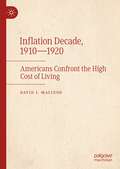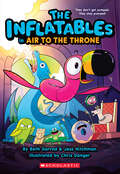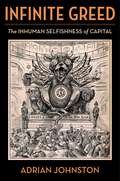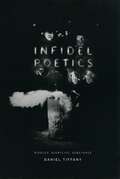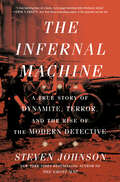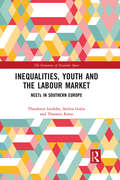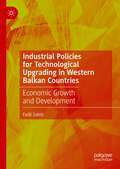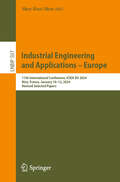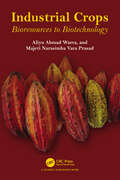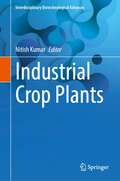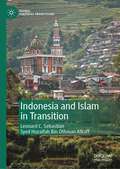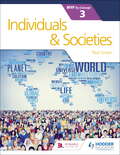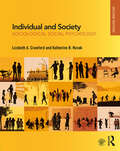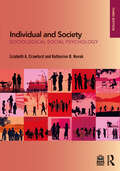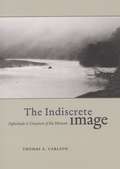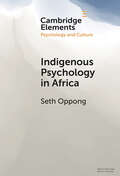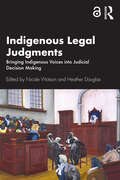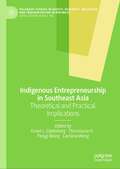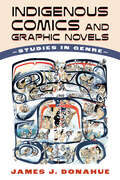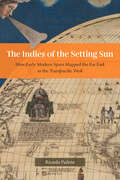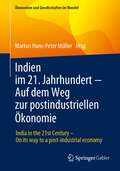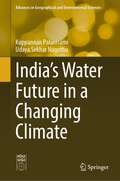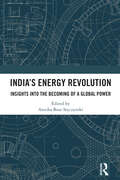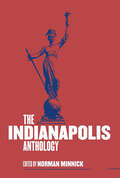- Table View
- List View
Inflation Decade, 1910—1920: Americans Confront the High Cost of Living
by David I. MacleodThis book shows how inflation can disrupt politics and society. With no recent precedent, mild inflation spurred mass protests, myriad remedial schemes, and partisan political reversals between 1910 and 1914. Then wartime demand and inflationary fiscal policy doubled consumer prices from 1915 to 1920, triggering waves of strikes, food riots by immigrant housewives, class conflict, and elite fears of revolution. Middle-class households resented falling real incomes. Even more than today, food prices dominated consumer concerns. Yet farmers wanted high commodity prices. Accordingly, both sides blamed and attacked meatpackers, wholesalers, and retailers. Then as now, inflation hurt whichever party held the White House. Fumbling responses by Wilson’s administration and the Federal Reserve led to hesitant price controls, punitive raids and prosecutions, and a now-familiar fallback—high interest rates in 1920 and subsequent recession. An epilogue traces continuing popular and politicalresponses to changes in the consumer price index down to 2020.
The Inflatables in Air to the Throne (The Inflatables)
by Beth Garrod Jess HitchmanThe Inflatables don't get pumped. They stay pumped! Inflata-pals and bouncy BFFs Cactus, Flamingo, Donut, and Watermelon are ready for a fresh wave of drama in this hilariously action-packed graphic novel series that’s perfect for fans of Dog Man and The Bad Guys!When an Airy Frogfather grants Flamingo’s wish for a fancy new home for his inflata-pals, he's pumped! But to claim the palace, the gang will have to go up against Sir-Spits-A-Lot, an evil inflatable llama who won't give up the castle easily. Will Flamingo have what it takes to survive llamagedon and become the rightful air to the throne?
Infinite Greed: The Inhuman Selfishness of Capital (Insurrections: Critical Studies in Religion, Politics, and Culture)
by Adrian JohnstonSelfishness is essential to capitalism—or so both advocates and opponents claim. In Infinite Greed, Adrian Johnston argues that this consensus is mistaken. Through a novel synthesis of Marxism and psychoanalysis, he reveals how the relentless pursuit of profits is not fundamentally animated by human acquisitiveness. Instead, capitalism’s strange “infinite greed” demands that individuals sacrifice their pleasures, their well-being, and even themselves to serve inhuman capital.Johnston traces the mechanisms that compel capitalist subjects to obey the cold imperative to accumulate in perpetuity and without limits—and also without regard for the consequences for everyone and everything else. Facing crises such as spiraling wealth inequality and the profit-driven prospect of a looming ecological apocalypse, the rational self-interest of the majority would seem to dictate putting a stop to capitalist accumulation. By bringing together the Marxian critique of political economy with psychoanalytic metapsychology, Johnston shows why and how capitalism, rather than being responsive to people’s rationally selfish interests, disregards and overrides them instead.Unlike previous syntheses of Marxism and psychoanalysis, Infinite Greed pairs Freudian and Lacanian concepts with the economic heart of Marx’s historical materialism. In so doing, Johnston brings to light the complex intertwining of political and libidinal economies keeping us invested and complicit in perpetuating capitalism and its ills.
Infidel Poetics: Riddles, Nightlife, Substance
by Daniel TiffanyPoetry has long been regarded as the least accessible of literary genres. But how much does the obscurity that confounds readers of a poem differ from, say, the slang that seduces listeners of hip-hop? Infidel Poetics examines not only the shared incomprensibilities of poetry and slang, but poetry's genetic relation to the spectacle of underground culture. Charting connections between vernacular poetry, lyric obscurity, and types of social relations—networks of darkened streets in preindustrial cities, the historical underworld of taverns and clubs, the subcultures of the avant-garde—Daniel Tiffany shows that obscurity in poetry has functioned for hundreds of years as a medium of alternative societies. For example, he discovers in the submerged tradition of canting poetry and its eccentric genres—thieves’ carols, drinking songs, beggars’ chants—a genealogy of modern nightlife, but also a visible underworld of social and verbal substance, a demimonde for sale. Ranging from Anglo-Saxon riddles to Emily Dickinson, from the icy logos of Parmenides to the monadology of Leibniz, from Mother Goose to Mallarmé, Infidel Poetics offers an exhilarating account of the subversive power of obscurity in word, substance, and deed.
The Infernal Machine: A True Story of Dynamite, Terror, and the Rise of the Modern Detective
by Steven Johnson&“A fast-burning fuse of a book, every page bursting with revelatory detail.&”—ERIK LARSONA sweeping account of the anarchists who terrorized the streets of New York and the detective duo who transformed policing to meet the threat—a tale of fanaticism, forensic science, and dynamite from the bestselling author of The Ghost Map Steven Johnson&’s engrossing account of the epic struggle between the anarchist movement and the emerging surveillance state stretches around the world and between two centuries—from Alfred Nobel&’s invention of dynamite and the assassination of Czar Alexander II to New York City in the shadow of World War I. April 1914. The NYPD is still largely the corrupt, low-tech organization of the Tammany Hall era. To the extent the police are stopping crime—as opposed to committing it—their role has been almost entirely defined by physical force: the brawn of the cop on the beat keeping criminals at bay with nightsticks and fists. The solving of crimes is largely outside their purview. The new commissioner, Arthur Woods, is determined to change that, but he cannot anticipate the maelstrom of violence that will soon test his science-based approach to policing. Within weeks of his tenure, New York City is engulfed in the most concentrated terrorism campaign in the nation&’s history: a five-year period of relentless bombings, many of them perpetrated by the anarchist movement led by legendary radicals Alexander Berkman and Emma Goldman. Coming to Woods&’s aide are Inspector Joseph Faurot, a science-first detective who works closely with him in reforming the police force, and Amadeo Polignani, the young Italian undercover detective who infiltrates the notorious Bresci Circle. Johnson reveals a mostly forgotten period of political conviction, scientific discovery, assassination plots, bombings, undercover operations, and innovative sleuthing. The Infernal Machine is the complex pre-history of our current moment, when decentralized anarchist networks have once again taken to the streets to protest law enforcement abuses, right-wing militia groups have attacked government buildings, and surveillance is almost ubiquitous.
Inequalities, Youth and the Labour Market: NEETS in Southern Europe (The Dynamics of Economic Space)
by Theodoros Iosifides Stelios Gialis Thanasis KizosThis book thoroughly examines the socio-economic and labour market paths of young NEETs, particularly migrants and women, in the disadvantaged regions of Mediterranean Southern Europe – specifically, the island, coastal and peripheral areas of Greece, Cyprus, Italy and Spain.
Industrial Policies for Technological Upgrading in Western Balkan Countries: Economic Growth and Development
by Fadil SahitiThis book focuses on Albania, North Macedonia and Kosovo; it explores the industrial policies currently in place in these economies and compares their effects with the situation in Slovenia, which is used as a reference country. It provides a brief introduction to some new industrial policy approaches and proposes a new industrial policy framework that focuses on development of the national innovation system through technology upgrading and increased exploitation of technology to build the foundations for sustainable development. Finally, it provides an empirical analysis of the technological capabilities of the manufacturing firms operating in in Albania, North Macedonia and Kosovo.It delves into the technical-economic properties of these Western Balkans countries and identifies some strategic options for industrial policy. It emphasizes the need for a form of governance that emphasizes on industrial development and innovation capabilities, which are required for the implementation of these new industrial policies. The analysis draws on the current industrial policy literature and work on developing (catch-up) economies, technological upgrading and innovation studies, which represent current academic thinking in these fields.
Industrial Engineering and Applications – Europe: 11th International Conference, ICIEA-EU 2024, Nice, France, January 10–12, 2024, Revised Selected Papers (Lecture Notes in Business Information Processing #507)
by Shey-Huei SheuThis book constitutes the refereed post-proceedings of the 11th International Conference on Industrial Engineering and Applications, ICIEA 2024, held in Nice, France, during January 10-12, 2024. The 16 full papers and 3 short papers included in this book were carefully reviewed and selected from 90 submissions. They focus on the most recent and relevant research, theories and practices in industrial engineering and its applications.
Industrial Crops: Bioresources to Biotechnology
by Aliyu Ahmad Warra Majeti Narasimha PrasadThis book captures how industrial crops can be used in conventional agriculture and greener biopharming for pharmaceutical industries. Pharmaceuticals and industrial compounds are studied from the perspective of their co-existence with plant resources and byproducts. Such plant-based industrial products rely on scientific and technological breakthroughs and provide new opportunities for the agricultural sector, at the same time mitigate the risks associated with climate change. The management of the externalities and of the possible unintended economic effects that arise in this context is critical and poses difficult questions for regulators. The book also provides a review of the emerging agro-industrial biomass technology involved in conversion of most of the solid transgenic industrial crops by products such as plant oil lignocellulosic materials into liquid biobased energy-fuels. The book covers how innovative biotechnology can expand the markets for agricultural producers worldwide, reduce environmental degradation, and provide alternatives to fossil carbon-derived products and energy. Aspects of entrepreneurial biotechnology and bioprospecting are also covered.
Industrial Crop Plants (Interdisciplinary Biotechnological Advances)
by Nitish KumarIndustrial crops offer farmers new market opportunities to increase their revenue by producing high-value products, focusing on fiber, forest, and energy crops, industrial oilseeds, rubber and resins, pharmaceuticals, and more. Technological innovations in agriculture have facilitated higher yields, but conserving crop genetic resources and diversity remains crucial for sustainable agricultural production. This poses a challenge that can be addressed through modern tools of biotechnology and genomics, utilizing the wealth of sequenced plant genomes. This book addresses the need for knowledge in managing the risks and conservation of genetic diversity associated with advanced technology. It provides comprehensive coverage of plant genomics and biotechnology, catering to post-graduate students, researchers, employees of seed and biotechnology companies, as well as instructors in plant genetics, breeding, and biotechnology fields.
Indonesia and Islam in Transition (Global Political Transitions)
by Leonard C. Sebastian Syed Huzaifah Othman AlkaffThis book focuses on Islam in Indonesia, showcasing the wide range of Muslim organisations, belief systems and movements, together with an analysis of the political behaviour of Indonesian Muslims. It includes an investigation of the structure of groups, organizations, and societies, and how Muslims within the archipelago interact within these contexts. In doing so, it promotes a more nuanced understanding of Indonesian Muslim society by approaching it through the utilisation of scholarly frameworks. Theories related to religion and society are used, especially in characterising the transition of the Indonesian Muslim society from pre-New Order to post-New Order. Particularly significant is Abdullah Saeed's framework in understanding one’s attitude towards key and contemporary issues, originally used to understand one’s attitude towards the religious ‘other’. The authors thus adopt this framework in the book, as a method of categorising people in a diverse society which in turnhelps readers to understand the nuances of Islam and Muslims in a huge country like Indonesia.
Individuals and Societies for the IB MYP 3
by Paul GraceA concept-driven and assessment-focused approach to Individual and societies teaching and learning.- Approaches each chapter with statements of inquiry framed by key and related concepts, set in a global context- Supports every aspect of assessment using tasks designed by an experienced MYP educator- Differentiates and extends learning with research projects and interdisciplinary opportunities- Applies global contexts in meaningful ways to offer an MYP Individual and societies programme with an internationally-minded perspective
Individuals and Societies for the IB MYP 3
by Paul GraceA concept-driven and assessment-focused approach to Individual and societies teaching and learning.- Approaches each chapter with statements of inquiry framed by key and related concepts, set in a global context- Supports every aspect of assessment using tasks designed by an experienced MYP educator- Differentiates and extends learning with research projects and interdisciplinary opportunities- Applies global contexts in meaningful ways to offer an MYP Individual and societies programme with an internationally-minded perspective
Individual and Society: Sociological Social Psychology
by Lizabeth A. Crawford Katherine B. NovakUnlike other texts for undergraduate sociological social psychology courses, this text presents the three distinct traditions in sociological social psychology—symbolic interactionism, social structure and personality, and group processes and structures—and emphasizes the different theoretical frameworks within which social psychological analyses are conducted within each research tradition. With this approach, the authors make clear the link between sociological social psychology, theory, and methodology. Students will gain a better understanding of how and why social psychologists trained in sociology ask particular kinds of questions; the types of research they are involved in; and how their findings have been, or can be, applied to contemporary societal patterns and problems.This new, second edition includes the latest research on topics related to current events and changing societal patterns; more detailed discussions on intersectionality, social media, and contemporary social movements; as well as a new concluding chapter that asks students to reflect on what they have learned about sociological social psychology and its applicability to contemporary social issues. Engaging exercises and group activities are also embedded within in each chapter to enhance students’ understanding of key concepts, theories, methods and research findings within the field and how they relate to everyday life.
Individual and Society: Sociological Social Psychology
by Lizabeth A. Crawford Katherine B. NovakUnlike other texts for undergraduate sociological social psychology courses, Individual and Society covers each of the three research traditions in sociological social psychology—symbolic interactionism, social structure and personality, and group processes and structures. With this approach, the authors make clear the link between sociological social psychology, theory, and methodology. Students will gain a better understanding of how and why social psychologists trained in sociology ask particular kinds of questions; the types of research they are involved in; and how their findings have been, or can be, applied to contemporary societal patterns and problems.This new, third edition makes the emphasis on social inequality within sociological social psychology, a key theme in earlier versions of the book, more salient throughout the text by including new or expanded discussions of intersectionality, positionality, the experiences of gender and sexual minorities, racial microaggression, contemporary social movements, and the complexities of allyship. Other additions to the text address the ubiquity of the Internet and social media, where the authors consider how these phenomena have shaped the experiences of Generation Z, the first “digital natives,” and altered individuals’ self-concepts and social relationships. Engaging exercises and group activities are also embedded within each chapter to enhance students’ readiness to reflect and think critically about the social world around them and to improve their understanding of the different dimensions of sociological social psychology and how they relate to everyday life.
The Indiscrete Image: Infinitude & Creation of the Human (Religion And Postmodernism Ser.)
by Thomas A. CarlsonHumanity’s creative capacity has never been more unsettling than it is at our current moment, when it has ushered us into new technological worlds that challenge the very definition of “the human.” Those anxious to safeguard the human against techno-scientific threats often appeal to religious traditions to protect the place and dignity of the human. But how well do we understand both theological tradition and today’s technological culture? In The Indiscrete Image, Thomas A. Carlson challenges our common ideas about both, arguing instead that it may be humanity’s final lack of definition that first enables, and calls for, human creativity and its correlates—including technology, tradition, and their inextricable interplay within religious existence. Framed in response to Martin Heidegger’s influential account of the relation between technological modernity and theological tradition, The Indiscrete Image builds an understanding of creativity as conditioned by insurmountable unknowing and incalculable possibility through alternative readings of Christian theological tradition and technological culture—and the surprising resonance between these two. Carlson concludes that the always ongoing work of world creation, tied essentially to human self-creation, implies neither an idol’s closure nor an icon’s transcendence, but the “indiscrete image” whose love makes possible—by keeping open—both the human and its world.
Indigenous Psychology in Africa: A Survey of Concepts, Theory, Research, and Praxis (Elements in Psychology and Culture)
by null Seth OppongUnderstanding human behaviour, thoughts, and emotional expressions can be challenging in the global context. Due to cultural differences, the study of psychology cannot be de-contextualised. This calls for unearthing of the explanatory systems that exist in Africa to understand and account for behaviour, emotions, and cognition of Africans. This call is addressed through the emergence of African Psychology (AP) or Indigenous Psychology in Africa (IPA) as a legitimate science of human experience. This Element discusses the motivations for AP, centrality of culture, demarcations of AP, and the different strands within AP. It highlights issues related to African philosophy, African cultural anthropology, African philosophy of science, and suitable methodological approaches for AP research. It also discusses some selected theoretical contributions and applications of AP. The Element concludes that AP researchers and practitioners need to pursue interdisciplinarity and avoid meaningless rejection of good ideas from other cultural settings.
Indigenous Legal Judgments: Bringing Indigenous Voices into Judicial Decision Making
by Nicole Watson and Heather DouglasThis book is a collection of key legal decisions affecting Indigenous Australians, which have been re-imagined so as to be inclusive of Indigenous people’s stories, historical experience, perspectives and worldviews.In this groundbreaking work, Indigenous and non-Indigenous scholars have collaborated to rewrite 16 key decisions. Spanning from 1889 to 2017, the judgments reflect the trajectory of Indigenous people’s engagements with Australian law. The collection includes decisions that laid the foundation for the wrongful application of terra nullius and the long disavowal of native title. Contributors have also challenged narrow judicial interpretations of native title, which have denied recognition to Indigenous people who suffered the prolonged impacts of dispossession. Exciting new voices have reclaimed Australian law to deliver justice to the Stolen Generations and to families who have experienced institutional and police racism. Contributors have shown how judicial officers can use their power to challenge systemic racism and tell the stories of Indigenous people who have been dehumanised by the criminal justice system.The new judgments are characterised by intersectional perspectives which draw on postcolonial, critical race and whiteness theories. Several scholars have chosen to operate within the parameters of legal doctrine. Some have imagined new truth-telling forums, highlighting the strength and creative resistance of Indigenous people to oppression and exclusion. Others have rejected the possibility that the legal system, which has been integral to settler-colonialism, can ever deliver meaningful justice to Indigenous people.The Open Access version of this book, available at http://www.taylorfrancis.com, has been made available under a Creative Commons Attribution-Non Commercial-No Derivatives (CC-BY-NC-ND) 4.0 license.
Indigenous Entrepreneurship in Southeast Asia: Theoretical and Practical Implications (Palgrave Studies in Equity, Diversity, Inclusion, and Indigenization in Business)
by Emiel L. Eijdenberg Thirumaran K Pengji Wang Caroline WongThis book provides an in-depth exploration of indigenous entrepreneurship and its challenges while addressing ways to make businesses more inclusive and sustainable in the long term. Offering a balanced mix of critical perspectives, theoretical insights and practical implications, provided by both academics and practitioners, it examines how indigenous entrepreneurship practices in Southeast Asia challenge existing theories in business and management research. The chapters also explore the role of various stakeholders, such as the larger community and society, supply chain members, policy-makers, etc., in facilitating indigenous entrepreneurship.Highlighting the uniqueness and diversity of indigenous entrepreneurship in Southeast Asia, this book renders a comprehensive overview of contemporary indigenization topics, organized by Southeast Asian cultural and national contexts.
Indigenous Comics and Graphic Novels: Studies in Genre
by James J. DonahueIn recent years, studios like Marvel and DC have seen enormous success transforming comics into major motion pictures. At the same time, bookstores such as Barnes & Noble in the US and Indigo in Canada have made more room for comic books and graphic novels on their shelves. Yet despite the sustained popular appeal and the heightened availability of these media, Indigenous artists continue to find their work given little attention by mainstream publishers, booksellers, production houses, and academics. Nevertheless, Indigenous artists are increasingly turning to graphic narratives, with publishers like Native Realities LLC and Highwater Press carving out ever more space for Indigenous creators. In Indigenous Comics and Graphic Novels: Studies in Genre, James J. Donahue aims to interrogate and unravel the disparities of representation in the fields of comics studies and comics publishing. Donahue documents and analyzes the works of several Indigenous artists, including Theo Tso, Todd Houseman, and Arigon Starr. Through topically arranged chapters, the author explores a wide array of content produced by Indigenous creators, from superhero and science fiction comics to graphic novels and experimental narratives. While noting the importance of examining how Indigenous works are analyzed, Donahue emphasizes that the creation of artistic and critical spaces for Indigenous comics and graphic novels should be an essential concern for the comics studies field.
The Indies of the Setting Sun: How Early Modern Spain Mapped the Far East as the Transpacific West
by Ricardo PadrónPadrón reveals the evolution of Spain’s imagining of the New World as a space in continuity with Asia. Narratives of Europe’s westward expansion often tell of how the Americas came to be known as a distinct landmass, separate from Asia and uniquely positioned as new ground ripe for transatlantic colonialism. But this geographic vision of the Americas was not shared by all Europeans. While some imperialists imagined North and Central America as undiscovered land, the Spanish pushed to define the New World as part of a larger and eminently flexible geography that they called las Indias, and that by right, belonged to the Crown of Castile and León. Las Indias included all of the New World as well as East and Southeast Asia, although Spain’s understanding of the relationship between the two areas changed as the realities of the Pacific Rim came into sharper focus. At first, the Spanish insisted that North and Central America were an extension of the continent of Asia. Eventually, they came to understand East and Southeast Asia as a transpacific extension of their empire in America called las Indias del poniente, or the Indies of the Setting Sun.The Indies of the Setting Sun charts the Spanish vision of a transpacific imperial expanse, beginning with Balboa’s discovery of the South Sea and ending almost a hundred years later with Spain’s final push for control of the Pacific. Padrón traces a series of attempts—both cartographic and discursive—to map the space from Mexico to Malacca, revealing the geopolitical imaginations at play in the quest for control of the New World and Asia.
Indien im 21. Jahrhundert − Auf dem Weg zur postindustriellen Ökonomie: India in the 21st Century – On its way to a post-industrial economy (Ökonomien und Gesellschaften im Wandel)
by Markus Hans-Peter MüllerAngesichts seiner fast 1,4 Milliarden Einwohner, seiner wirtschaftlichen Entwicklung und geopolitischen Attraktivität hat Indien das Potenzial, eine führende Weltmacht zu werden. Ein Großteil dieses Potenzials ist Wirklichkeit. Indien ist heute vor China die am schnellsten wachsende Volkswirtschaft der Welt. Aber Indien kämpft nicht nur mit seiner Zukunft, sondern auch mit Herausforderungen der Gegenwart, wie der Armut und ernsthafter Umweltbedenken. Unter der Annahme, dass China morgen aufhört zu wachsen, und dass Indien jährlich um 7 bis 8 Prozent wächst und sein Einkommen alle zehn Jahre verdoppelt, würde Indien China immer noch nicht vor 2050 einholen. Ohne wirtschaftliche und technologische Schlagkraft werden Indiens Ambitionen, bald eine Großmacht zu werden, genau das bleiben: Ambitionen. Das Buch besteht aus deutsch- und englischsprachigen Beiträgen und umfasst Themen wie das soziale und kulturelle Fundament Indiens, die Ökonomie Indiens, das Finanzwesen und die indische Politik vor dem Hintergrund regional und globaler Strukturen oder Indiens strukturelle Herausforderungen, wie z.B. die Frage der Nachhaltigkeit sowie der Urbanisierung und Digitalisierung.
India's Water Future in a Changing Climate (Advances in Geographical and Environmental Sciences)
by Kuppannan Palanisami Udaya Sekhar NagothuThis book comprehensively addresses the most challenging water issues in India in a changing climate for the first time and suggests potential solutions. It has been observed that over the past two decades, water usage has significantly increased in India due to population growth, economic development and an increase in multiple uses of water, including irrigation, hydropower, industries, domestic consumption, fisheries, eco-system needs and the environment. India’s water future is mainly influenced by rising food demand to feed the increasing population, emerging climate change impacts on agriculture and the water sector, the increasing cost of interventions, poor cost recovery, the low level of technology adoption and weak water policy.Artificial recharge of the groundwater aquifers, improved water use efficiency and the groundwater–energy–agriculture nexus are important for the future of India’s water planning and are well addressed in this book. Also covered are climate-smart practices, wastewater reuse methods, and digital water and agriculture tools. The book further analyses improved irrigation modernization plans and explores the potential for micro-irrigation expansion including canal and tank irrigation systems in the country.Overall, this book is one of the first of its kind to present India’s future water and irrigation issues with field-based solutions, providing lessons learnt from successful national and international case studies. The volume is a useful resource for a wide range of readers including policy makers, planners, donors, implementing agencies and researchers in the water sector.
India’s Energy Revolution: Insights into the Becoming of a Global Power
by Annika Bose StyczynskiIndia is the third-largest emitter of greenhouse gases, which makes it an important player whose climate mitigation actions and inactions are closely scrutinised. This book studies developments in India’s energy system from a governance perspective. It presents a unique compilation and synthesis of research findings that capture achievements, shortcomings, and persistent and transient challenges of India’s transition towards a net-zero economy by 2070.The book grounds its analysis in domestically formulated goals and reflects on dynamics at the structural level of India’s multi-scalar innovation system, by highlighting the influencing factors of energy system status and change. It presents the perspectives and positions of different actor groups, studies the market and business, and discusses cases influenced by existing or changing institutions across the whole spectrum of energy resources from fossil to non-fossil fuels and respective technologies.The volume will be useful for students and researchers in energy governance, energy policy and economics, socio-technical transition studies, energy systems engineering, sustainable development, and environmental studies. It will also be of interest to policymakers and investors.
The Indianapolis Anthology (Belt City Anthologies)
by Norman MinnickAn anthology of essays & poetry offering a reconsideration of one of America&’s most misunderstood cities. Is Indianapolis just another midwestern city to fly over on the way to bigger and better destinations? Or is it, as locals know, a place where different peoples and ideals converge to create a rich cultural center? The Indianapolis Anthology showcases Naptown&’s vibrancy and diversity with pieces from journalists, poets, historians, established community voices, and first-time writers. The Circle City is more than the home of the Indianapolis 500, John Dillinger, Kenneth &“Babyface&” Edmonds, Kurt Vonnegut, Prozac, and Wonder Bread. In these pages, you&’ll find: · lawn chairs in the beds of pick-ups · Punk rock in Naptown · suffragists and entrepreneurs · cement pietàs · dog bakeries and yoga studios · red brick bungalows and war memorials · steakburgers and Mexican seafood; pho and sauerbraten · and more In other words, you'll find images from a city that is truly a cross section of today&’s America. Edited by Norman &“Buzz&” Minnick and with contributions from Etheridge Knight, Terrance Hayes, Michael Martone, and Karen Kovacik. An insiders&’ look that will make you see a great midwestern city in a brand-new light.
